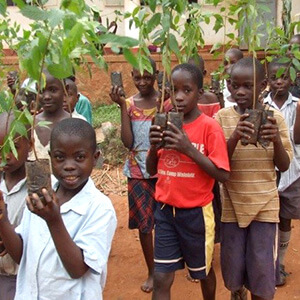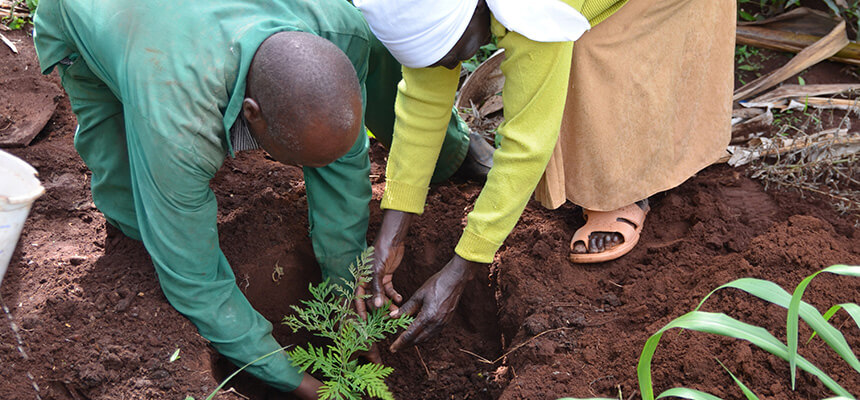 Green Light Revolution – food security and climate protection
Green Light Revolution – food security and climate protection
Deforestation and climate change in Uganda
Winston Churchill used to call Uganda "the pearl of Africa". Uganda was a green and fertile country with great biodiversity, situated between the mighty Lake Victoria, the White Nile and the misty Ruwenzori Mountains, home of the endangered mountain gorillas. In earlier times, the central region of Uganda stretched northwards from Lake Victoria in undulating forested hills. Today, these hills are built up and mostly bare. Studies have shown that between 1990 and 2010, Uganda has lost about 88.150 hectares of forest. In total, that is 31.7 % of its forested area (FAO, 2010). And the forest clearance continues. Thanks to Lake Victoria and the jungle, Uganda has had a tropical microclimate. This is now being lost – with fatal consequences for the entire region. 82 % of the people in Uganda directly or indirectly make a living from agriculture (Welthungerhilfe, 2015). 85 % of them are smallholder farmers with less than five acres of land. They overwhelmingly engage in rain-fed agriculture. Irrigation systems are almost unavailable. 90 % of their energy is supplied by fire wood, mostly for cooking. Because of climate change, the rainy seasons and precipitation patterns are shifting. The wet season, which used to come twice a year has now become unreliable: either it does not rain at all – causing harvest failures and loss of seeds – or there is flooding, washing away the topsoil and again causing loss of the harvest, if the small plots do not have sufficient borders, drainage or are protected by trees or hedgerows. For the smallholders it is thus becoming increasingly difficult to make a living from farming.
Necessity
Reforestration and organic farming for smallholder families in Uganda.
Activity
Five local NGOs and six rural schools support 2.500 farming families by setting up tree nurseries and train them in organic farming.
Countable effort
Number of trees that have been planted and tended on smallholders' land.
Result
It is expected that at least 833 farming families will be able to live off their diversified agroforestry.
Systemic effect
The locally based, living circular economy functions again and the smallholder families' food security combined with an income is assured.
Background
There is a vicious circle in rural poverty: in times of need, the smallholders themselves contribute to the destruction of biodiversity and natural resources. To generate income, trees are felled to sell them as timber, electricity pylons, fire wood or as charcoal. But without the vegetation cover, the land is even more vulnerable and at the mercy of extreme weather.
These days, the consequences of the destruction by logging and monocultures is in evidence everywhere: soil fertility is decreasing, the soils lose their ability to absorb water, the water table is falling. This has a further negative effect on the natural capacity for adaptation and resilience.
Only 34.4 percent of Uganda’s soil is arable land (World Bank, 2013). And the international trade in carbon certificates has also had ugly consequences: in recent years, international companies have planted large-scale wood plantations. What is intended to help against climate change, actually is a catastrophe for local farmers and their families: they are evicted from their land – sometimes violently. And the plantations are fenced monocultures of fast growing conifers riddled with pesticides, where animals cannot feed and with no possibilities for the farming families to engage in integrated forestry (Spiegel.de, 2015).
The good deed
The aim of the project is preserving the biodiversity as well as the adaptation to climate change through intensive integral reforestation, promoting sustainable forestry practices and by organic farming in 100 communities in central Uganda. Smallholder farmers particularly affected by poverty and to whose existence the negative effects of climate change are posing an acute threat are trained in ecological agroforestry and then implement the reforestation measures themselves. Thus they improve their standard of living of their respective communities by farming methods that are ecologically sustainable, promote biodiversity and are economically viable. In six rural schools, children are taught about environmental issues and learn to plant tree samplings both at the school's own farm and that of their parents.
Challenge
The main risk comes from extreme weather events – from failing rainy seasons and prolonged drought periods as well as from flooding. Especially in the early stages of the implementation when the reforestation measures have not yet taken full effect, these factors can have adverse consequences. However, these risks are addressed by the activities themselves and as the measures progress, these risks will effectively be reduced. There is the slight risk of misappropriation of the funds. Internal rules on transparency and participative monitoring processes ensure oversight on the correct, sparing and appropriate use of the funds as well as the suitable implementation of the measures at all levels.

AboutUganda
Kampala
Capital
39 032 400
Number of inhabitants
609 USD
Gross domestic product per capita per year
163
Human Development Index
48 % of people in Uganda are under 15. And: more than 80 % of Uganda's population make their living from agriculture. Climate change is threatening the future livelihoods of these young people.
About the organization and further information
Association
Zukunftsstiftung Entwicklung in der GLS Treuhand e.V.
DZI Seal-of-Approval
Further information and source
- http://weltbevoelkerung.de/fileadmin/content/PDF/Datenreport_2015_Stiftung_Weltbevoelkerung.pdf
- http://www.welthungerhilfe.de/fileadmin/user_upload/Themen/Millenniumsdoerfer/Finale_Berichte/Abschlussbereicht_Millenniumsdoerfer2015.pdf
- http://www.spiegel.de/wissenschaft/natur/uganda-waldprojekt-raubt-bauern-lebensraum-a-1065963.html
- http://www.wwf.de/fileadmin/fm-wwf/Publikationen-PDF/WWF_Waldzustandsbericht.pdf
- http://data.worldbank.org/indicator/AG.LND.ARBL.ZS




